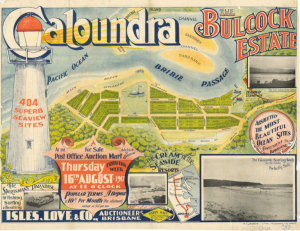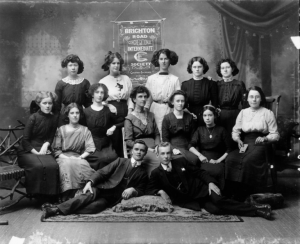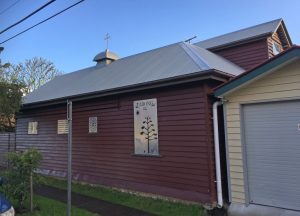The Osborne Family Build the House
Along with Dornoch Terrace, in the late 19th century Brighton Road was one of the dress circles of Highgate Hill, attracting the construction of substantial houses. One of the most impressive houses built along Brighton Road was the one at number 52, which is still standing today.

Brighton Road ca 1892. “Brighthelmstone” (later known as “Mon Abri”) is prominent at the far right of the image. (BCC archive)
William Henry Osborne and Jane Lilly Peat were married in Brisbane in 1869. William worked as an articled clerk and became associate to the first Queensland Chief Justice, Sir James Cockle. Amongst other duties, Osborn wrote the first Queensland volume of law reports.

Sir James Cockle, first Queensland Chief Justice 1863 – 1879 and mathematician. (State Library of Queensland)
In 1877 the couple purchased around one and a half acres of land on Brighton Road and lived in a house there called “Derwent”. In 1879, William was admitted as a solicitor. By this time, Jane had given birth to four children, although the first had died shortly after birth.
Ten years later in 1889, William became a partner in the firm Bernays and Osborne. This firm is mentioned regularly in newspapers regarding issues such as liquidations, wills, mortgage foreclosures and marriage issues. Amongst other things, William became what was known as a “Commissioner to take Acknowledgments of Married Women”. He also became secretary of the Queensland Law Association, later the Law Society.
With a family that had grown to seven children and an increased income, that year the Osbornes decided to build a grand home. To this end they took out a mortgage with a £2,000 loan from fellow lawyer George Valentine Hellicar.
The house had seven bedrooms on the first floor, a ground floor with drawing, dining and breakfast rooms, library, hall, kitchen, maid’s room and pantry as well as basement laundry and coal cellar.
The Osbornes called the house “Brighthelmstone” which was the original name of the town of Brighton in England.
Apart from advertisements for servants and a lost dog, there’s one interesting item of reporting regarding the family during their tenure in the house. The then famous Harmston’s Circus was in town and the family decided to have a night out. There was a sharp shooting act in which a character called Texas Jack fired a bullet to sever a rope. Unfortunately the bullet went wide and hit 16 year old Edward Osborne in the eye. Blood flowed copiously and Edward was taken to hospital.
As the circus was due to leave town and the sharpshooter and proprietor couldn’t pay the bail, they were arrested. They eventually paid damages of £200. Although his mother took the boy to Sydney to consult with a leading eye specialist, it seems he lost the use of his eye.
By 1901, the Osborne’s offspring had largely grown up and they announced via the social pages their intention to downsize. The following year they had an auction sale of their furniture and other effects, including Jane’s Victoria Phaeton carriage with silver mounted harness and whip. The house was rented for a while to a family by the name of Highfield and in 1903 it was purchased by new owners.
The Bulcocks Purchase the House
William Bulcock arrived in Australia from Lancashire in 1855 as a very young child, along with his parents and siblings. His father, Robert Bulcock, was a produce merchant who became well known as a politician serving in both the lower and now defunct upper Queensland houses of parliament. He was a strict Congregationalist and teetotaller which was reflected in his uncompromisingly non-conformist liberal politics.
The family name is remembered by the beach and a street in Caloundra. Robert purchased 277 acres in the area back in 1875 and another son, Robert Jnr. built a house on the cliff overlooking what is now Bulcock’s Beach and later subdivided the land.

A poster advertising the 1917 sale of Bulcock land at Caloundra, showing the location of the house. (State Library of Queensland).
In 1903 William, at 48 years of age, married Elizabeth Slattery in Melbourne. They purchased “Brighhelmstone” soon after.
It seems that the Bulcocks weren’t too fussed by the name “Brighthelmstone” and they renamed the house “Mon Abri”. The marble name plate was until recently in place on the front of the house.
Just across the street was a Congregational church and school, which may have influenced their decision to purchase the house, given the Bulcock family’s close connection with that Church. This is now the location of the Tangara Blue Care Retirement Village.
Mon Abri’s land stretched down to a long frontage on Baynes Street and also had access from End Street.
A 1921 sale advertisement for the house includes a description of the grounds. They included a fine croquet lawn and rose garden, stables, a fowl house and a poultry house as well as a cow shed and bail. The cow shed was probably similar to the one still standing at “Tarong” in Blakeney Street, Highgate Hill ( see my post A Strawberry Afternoon Tea Highgate Hill 1905 ).
Having a cow or two at home was popular where possible, as at the time milk was delivered in bulk and prone to causing health problems, especially for children (see my post Doctor A. Jefferis Turner – “Gentle Annie” ). In 1913, Elizabeth Bulcock was advertising for a gardener who could also milk cows.

Milk was still delivered in bulk and ice cooled, as long as the ice lasted, when this photo was taken on a Highgate Hill Street in 1914. (State Library of Queensland).
William worked for some time as an accountant and was a founding member of the Brisbane Stock Exchange in 1884. He became a very well known stock and share broker.
The Bulcocks had only one child, Beatrice, who was born in 1906. “Bebe”, as she was known, was often in the social pages.

Bebe Bulcock in the news, Sunday mail, 23rd September 1928. (TROVE) Page image from the National Library of Australia’s Newspaper Digitisation Program
William Bulcock passed away in 1930. The stock exchange was closed for a day in a sign of respect.
Two years later Elizabeth and Bebe headed off on a European trip. Bebe eventually married in 1944.

Article image from the Courier-Mail (Brisbane), 10th October 1933. National Library of Australia’s Newspaper Digitisation Program
Mon Abri Flats
By the time of these events however, the Bulcocks had sold the house and moved to Hamilton. We can imagine that they found the house very large for a family of just three. They put the place up for sale in October of 1921 and it was eventually sold in March 1922. The house was converted into flats which has remained its use for almost 100 years. By the time the City Council Detail Plan was prepared in 1926, most of the 1 1/2 acres had been sold off with just 40 perches remaining.
Mon Abris flats remained for a time a fashionable place to live, with occasional mentions in the social pages.
One unfortunate early resident was Margaret Jennings. Her husband was found in his timber-getting hut near Landsborough with his throat cut and a razor on his chest, having committed suicide. She moved with her children to Mon Abris flats in 1925.
Not long after, her daughter Kathleen was heading off on a boating trip to Moreton Bay. Whilst being rowed out to the boat at Hamilton, she went to shift seats in the dingy and fell into the choppy waters of the river. Despite one of the company diving in to search for her, her body wasn’t found until some weeks later, far down the river.
The house has passed through a number of owners since then and has made occasional appearances in the news. In 1942, for example, a sting operation by the US Army caught out a sly grog operation operating from the flats.

Courier-Mail (Brisbane), 29th October, 1942. (TROVE) Article image from the National Library of Australia’s Newspaper Digitisation Program
The house is currently (August 2019) undergoing restoration and redevelopment.
The original article is at this link















